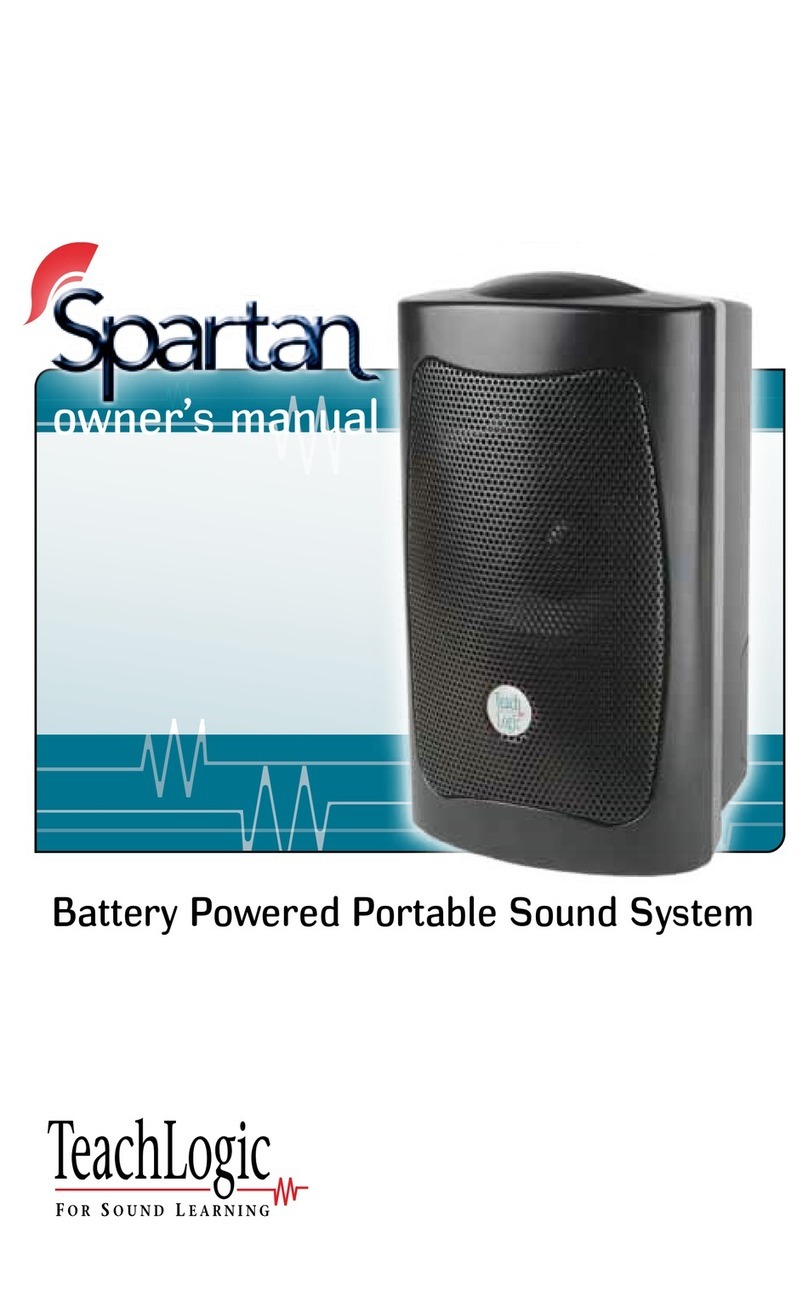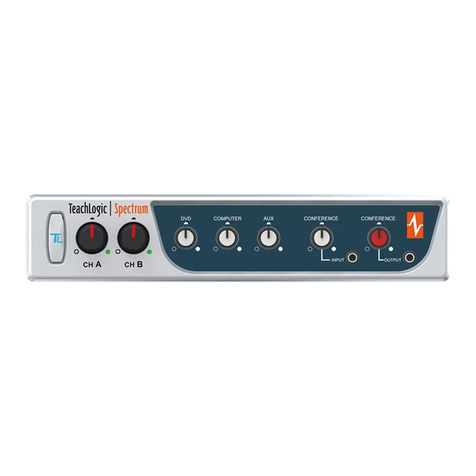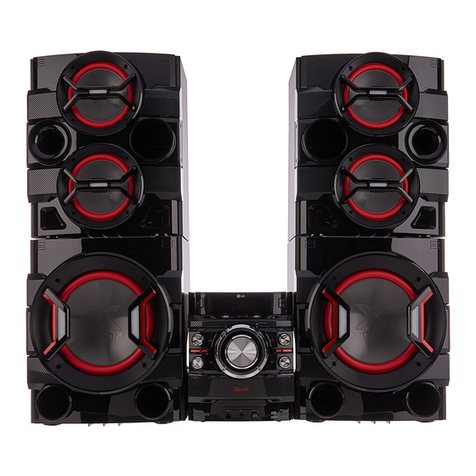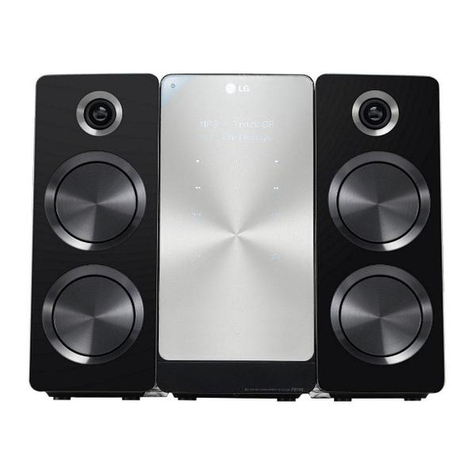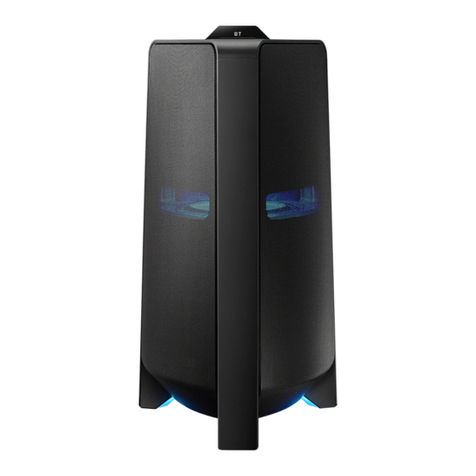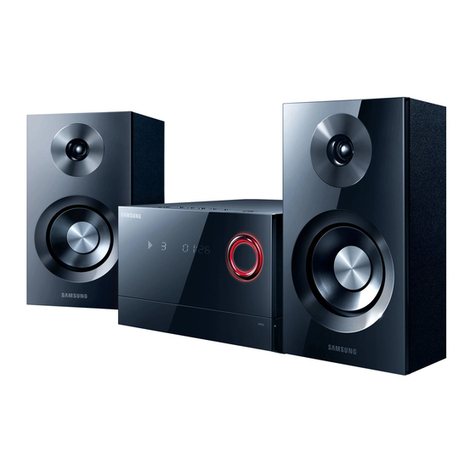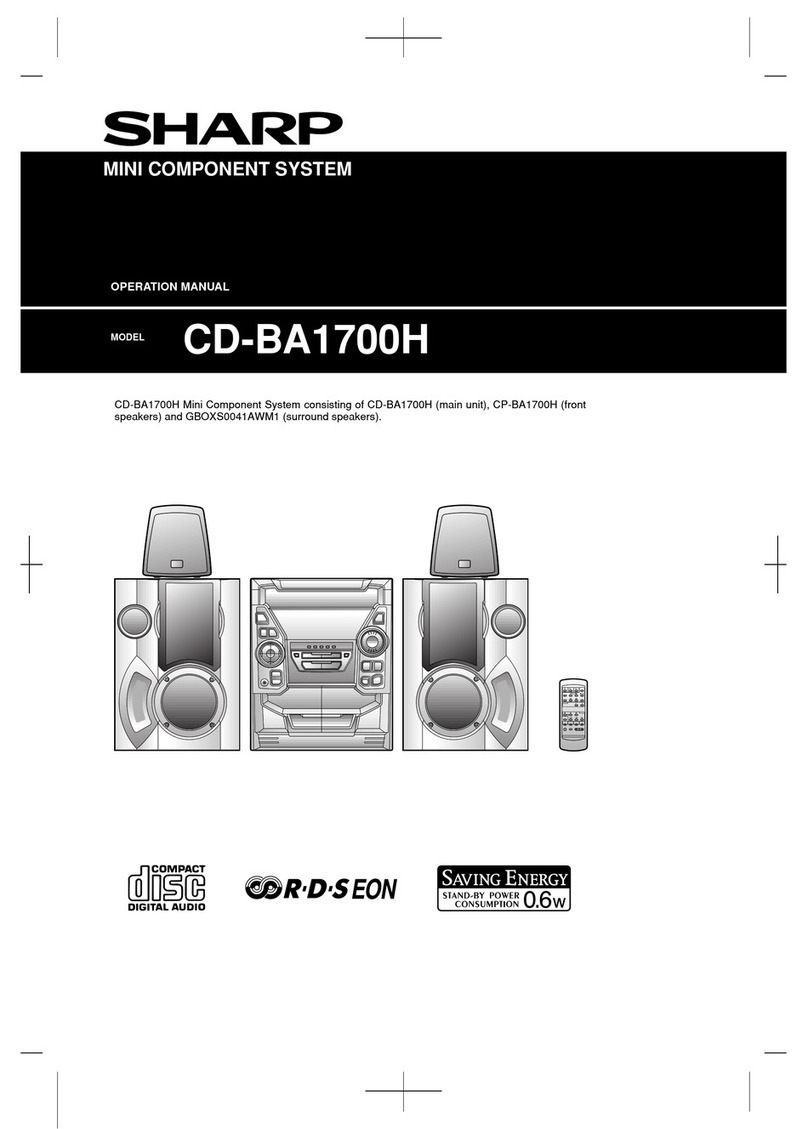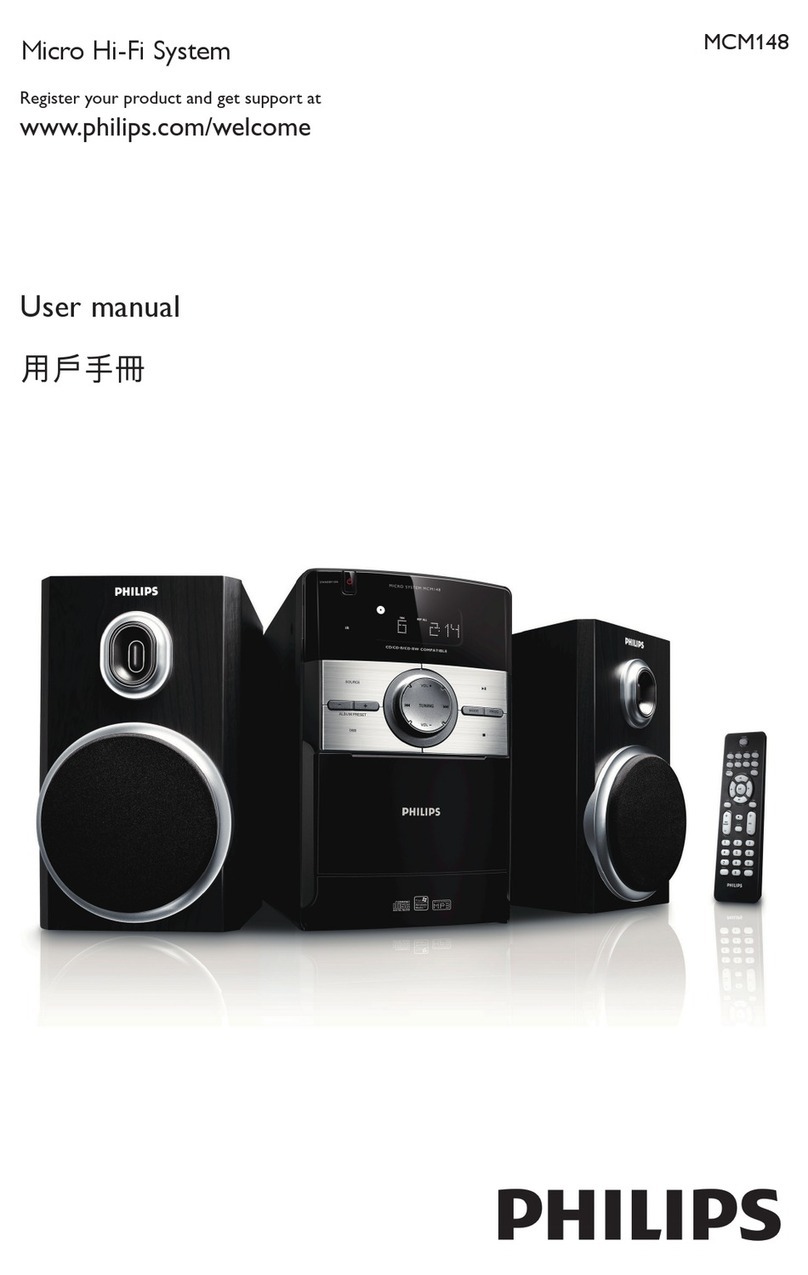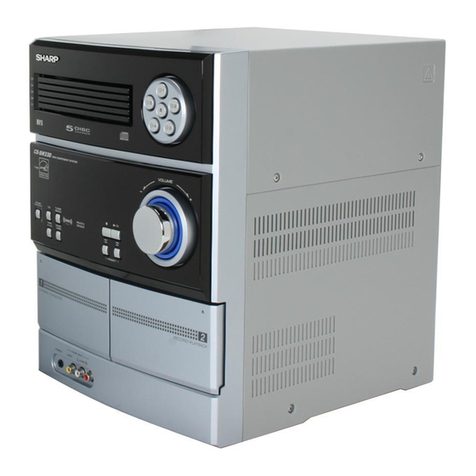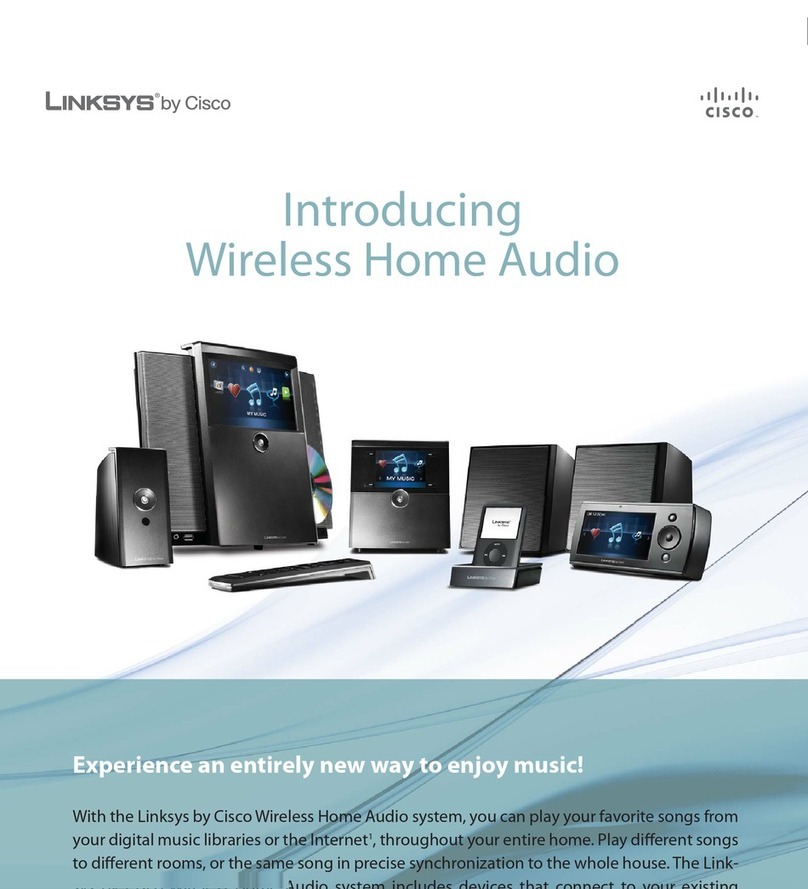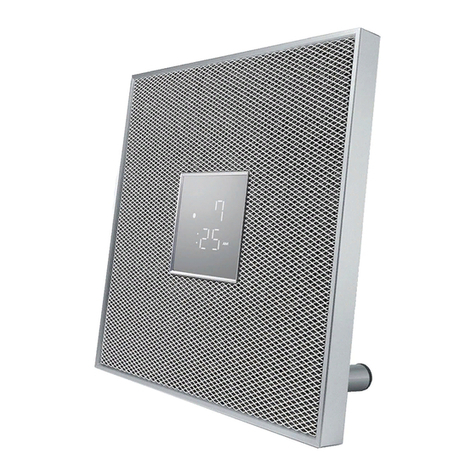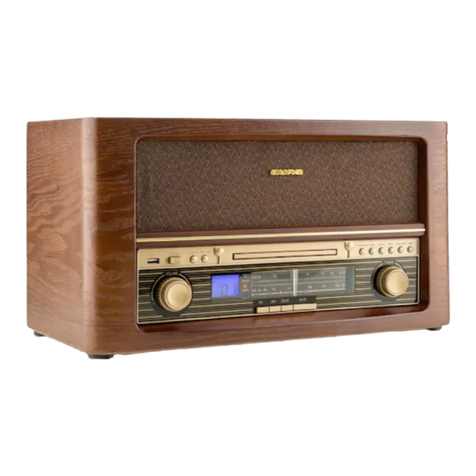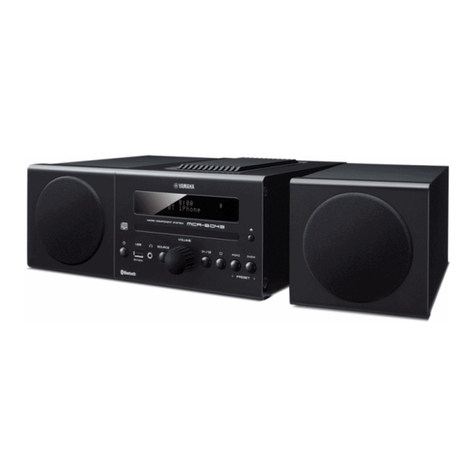TeachLogic QUANTUM II User manual

QUANTUM II
Infrared Sound Field System
User Guide

FORWARD
Congratulations on the purchase of your new QUANTUM II sound field system
produced by TeachLogic. Be assured that the Quantum has met all
manufacturers’ specifications and it will fulfill all your expectations. TeachLogic
incorporates state of the art technology, employs the most advanced
manufacturing methodology and uses only premium quality components to
assure you many years of reliable performance. Thank you for your confidence in
selecting TeachLogic products and we intend to support our products to your
complete satisfaction.
We hope you will take some time to review this manual to familiarize yourself with
the product features and help you understand its performance. We are confident
that the manual will help you gain the maximum use and benefit of the Quantum
II sound field system.
The manual provides a basic explanation on Infrared transmission and its
benefits. Then there are some guidelines to help with unit location and
installation instruction.
The manual continues with product description, followed by operational and use
instructions. The manual concludes with maintenance procedures and trouble
shooting analysis.
If you should encounter any difficulty or need further assistance, contact
TeachLogic customer service department.
Tel: 800-588-0018
Brian Van Waay
President

A Brief Explanation of Infrared
Infrared is a light ray that is below the visible light spectrum (you can’t see it),
just like the sound spectrum extends beyond your hearing ability. The same as;
infrared transmission is used in the remote control of your TV set. A beam of
infrared light is emitted by a Light Emitting Diode (LED) from the remote control
and it is detected by a receiving diode in your TV set. When you push a certain
command on your control, the internal electronics causes the infrared light to
flicker in a programmed sequential pattern (called modulating the light beam).
That pattern is detected by the receiving diode and is electronically decoded to
send a command to the TV set to perform the command you have programmed
into your TV set.
So how does this apply to the infrared communication system which you are
about to start using? Well, the body-pack transmitter or handheld microphone
has several Light Emitting Diodes (LED) that emit infrared light beams to a sensor
located on the top of your Quantum II (that dark shining trim atop the Quantum
II). Now, when you talk into the microphone, the internal electronics in the
handheld or body-pack transmitter causes the light beam to flicker at the same
sequence as your breath varies from your voice when you speak into the
microphone. That sequential signal is detected by the sensor and a coded
electronic signal is sent to the receiver in the Quantum II. The receiver decodes
the electronic signal and converts it into electronic signal. The signal is routed to
the amplifier. The amplifier strengthens (amplifies) the electronic signal and
makes it strong enough to cause the speaker to move back and forth at the same
variation as your breath varied into the microphone. Now the replicate of your
voice is reproduced by the speaker, creating an audible sound level so all can
hear with ease.
Due to the number and strength of the diodes in the transmitter and sensitivity of
the Quantum II sensor, the IR signal will bounce off of walls, ceiling and floor and
be received by the sensor without interruption. However, infrared will not
penetrate solid surfaces, therefore; transmission will not go outside of the room.
Some words of caution and limitations of infrared:
Be sure that the path of transmission between the emitter and sensor is not
obstructed.
The body-pack transmitter will not function if placed in pocket
Infrared will not work outdoors in sunlight
Dark soft surfaces do not reflect infrared very well and can cause some limitation
to distance of transmission (drop outs).
Rooms larger than 2500 Sq. Ft. or have high ceiling can begin to exceed the
ultimate performance of the Quantum II.
If you should experience drop outs in certain areas, you could install an
additional sensor (IWS-50) to extend the system performance.

INVENTORY OF PARTS – WHAT’S IN THE BOX?
IRQ-3000 series Quantum II is comprised of the following components.
1 ea. Quantum II single piece self-contained column sound system with a built-
in 30-watt integrated amplifier. (IRC – 320)
1 ea. AC Power adapter (AC-35)
1 ea One Drop-in Charger Base (BRC-30)
1 ea AC Power supply for Charger (AC-40)
1 ea Body-pack transmitter with rechargeable (NiMH) batteries (IRB-30)
1 ea Microphone to be plugged into the Body-Pack Transmitter
Plug-in Mic (LM-300) or
Lapel Mic (LM-385) or
Collar Mic (CM-835) or
Ultra Lite Mic (ULM-835) optional
1 ea Handheld Microphone with rechargeable NiMH batteries (IRH-30) optional
1 ea “U” shaped wall mounting bracket with mounting hardware
ASSEMBLY and INSTALLATION
Installing the Quantum II
A. The Quantum II can be operated as a free stance system on a speaker
stand. To use in this mode of operation:
Locate the system off to one side in the front of the room. Point the front
of the unit toward the center of the listening area. Find an AC outlet
and plug the system in.
Side wall location is also acceptable. Locate unit on either side about ¼
from front of room. Point the front diagonally across the listening area.
Locate an AC outlet and plug it in.
Optional: Folding Tripod Stand SS-300
B. Mounting the Quantum II on the wall, please review the following guidelines.
1. Selecting the most appropriate location for the Quantum can be the most
challenging. Every room is a little different, but in general the most
functional location is installing it on the front wall off to one side or the
other approximately ⅓from either side wall.
An alternate choice would be on either side wall, located approximately ¼ -
⅓the distance from the front of the room.
NOTE: Be conscious of an AC outlet requirement for power.
2. Once you’ve decided where to mount the Quantum II, hold the ‘U’ bracket
straight up and down against the wall with bottom of the bracket

approximately 5 -6 feet above the floor. Using a level to assure true vertical
orientation, mark the two mounting holes.
If installing onto a drywall, drill two ¼” holes and insert a molley bolt
provided. With a #2 Phillips head screwdriver, mount the wall bracket.
If installing into a wood or like material, use two sheet metal screws with
washers to mount the bracket to the wall.
For concrete wall, you’ll need to acquire and install a plastic insert for a # 8
sheet metal screw and install accordingly.
3. With the bracket mounted, route the plastic wire tie through the two tab
holes. Hold the power supply onto the two raised tabs with the AC plug end
toward the floor. With the power supply resting on the pegs, tighten the
wire tie thus securing the power supply to the bracket.
4. Insert the DC plug into the power input jack and place the Quantum II into
the bracket, secure each end with the ⅜” bolt and washer provided.
5. Orient the Quantum with center pointing diagonally across the listening
area.
6. Plug the power cord into an AC outlet
THE QUANTUM II CONTROLS
Channel A turns power “on/off” (red LED indicator) and adjusts the volume
of the IR microphone assigned to it. Normally the body-pack transmitter is
assigned to channel A. When the transmitter is turned “on” a green LED
will light, indicating that an IR signal is being received from the transmitter.
Channel B also turns power “on/off” and adjusts the volume of the
microphone assigned to it. Normally the handheld microphone is assigned
to channel B. When the transmitter is turned “on” an amber LED will light
indicating an IR signal is being received from the transmitter.
Tone control adjusts the tonal quality of the sound. You will feel a center
indent, turn CCW will boost the bass and turning CW will extenuate the
high frequencies.
Line input jack (3.5mm) facilitates connecting the output of a DVD, Video
Projector, ipod, computer and amplifying its signal through the Quantum.
The volume can be controlled with the adjacent knob.
Line output jack (3.5 mm) provides a composite line level output; it can be
used to connect to a personal FM assistive listening system or as an output
to a recording device. The small knob adjusts the output level to match
input of the device connected.
External speaker output connector is located adjacent to the power plug.
An unpowered external speaker can be connected to the Quantum for
additional coverage. A companion unpowered Quantum would be the
speaker of choice.

Quantum Controls
1. Threaded insert for wall mount
bracket.
2. External sensor inputs.
3. Internal sensors.
4. Internal speaker.
5. Power switch & Channel A Control.
6. Power switch & Channel B Control.
7. Power indicator LED.
8. Infrared wireless transmission LED.
9. Tone control.
10. Line input volume control.
11. Line output gain control.

DESCRIPTION OF THE IR TRANSMITTERS
The body-pack transmitter is usually pre-set to channel ‘A’ and the hand-held
microphone-transmitter set to channel ‘B.’ To change the channel on your body-
pack transmitter, open battery door, and move the small slide switch above the
batteries to desired channel. To change the channel on the handheld
microphone, unscrew the lower cover and move the small slide switch along side
the battery compartment to the desired channel.
Body-Pack Transmitter (IRB-30) is the component that has 10 emitting diodes
on its front panel and transmits the IR signal to the receiving sensor; the glossy
panel atop the Quantum front. The IRB-30 is shipped with rechargeable NiMH
batteries installed which may require charging prior to use. Controls include a
power “on/off” switch and a mic gain control (black knob on top). An external
microphone needs to be plugged in, top jack (3.5mm). The IRB-30 can be worn
around the neck using a lanyard or clipped onto the waist or other appropriate
support.
Remember: The body-pack cannot be placed in pocket.
Microphones Used with the Body-Pack
Plug-in Microphone (LM-300) The plug-in microphone is a small capsule
size microphone that plugs directly into the top 3.5mm input jack. A
lanyard cord is provided to wear the body-pack transmitter around the
neck as a pendant microphone. The capsule is unidirectional, thus
emphasizing its sensitivity to voice waves across its top surface making it a
very functional pendent microphone. A windscreen is provided to reduce
breath pops when used in close proximity to the mouth.

Ultra Lite Mic (ULM-835) The ULM-835 is a miniature boom style
microphone supported by a wire around the ear. The mic is worn on the left
side and is plugged into the 3.5mm jack. The ULM-835 features a
unidirectional element for excellent acoustic qualities and virtually
eliminates the hazard of feedback. The light weight for comfort, size and
natural color for visual; makes the Ultra Lite Mic a very desirable choice.
Collar Mic (CM-835) The collar microphone is a flexible rod with a
microphone installed in one end. The rod is formed around the neck and
the mic element oriented upward in proximity of the mouth. A windscreen
is provided to eliminate breath noise. The cord extends from the center in
back of neck and extends down out of the way to the body-pack. The collar
mic also incorporates a unidirectional element thus preventing feedback.
Lapel Microphone (LM-835) The lapel microphone is a small capsule like
microphone with a spring clip for securing on to a clothing edge. The lapel
microphone is well suited for use as a mic away from the face. The lapel
mic is also equipped with a unidirectional element for better pickup across
its top. If the lapel mic is worn reasonably close the mouth it will provide
very satisfactory performance. However; the lapel microphone is the mic
most prone to feedback when used near or under a speaker.
Handheld Microphone Transmitter (IRH-30) The handheld microphone is most
applicable for student use or for direct presentation. It is equipped with
rechargeable NiHM batteries and has 10 emitting diodes on the bottom of the
barrel. It has an on/off switch and a green “on” and battery level LED indicator. If
LED is red, the batteries will have to be charged before using.

You are now ready to test the system
To test the system, we are going to use a wireless body-pack transmitter
with microphone, handheld microphone and an auxiliary audio source
(DVD, CD Player, etc.)
Turn the Quantum “on”, using either large knob
Red LED will light to indicate power
Set the Ch. A and Ch. B controls to 12 0’clock
Using the Body – Pack Transmitter and Microphone
Set the body-pack gain control (black knob on top) to minimum, fully
CCW
Turn the body-pack “on” via the slide switch on the side of the body-
pack.
Observe the Green LED on top of body-pack transmitter. (If Red,
batteries must be charged or replaced).
Observe the Green LED adjacent to Ch. A volume control, it indicates
that an IR signal is being received from the body-pack.
If the Ch. B LED turns “on”, remove the battery cover of the body-
pack and slide the channel selector switch to Ch. A.
Speak into the microphone and adjust the volume using the gain
control on top of the body-pack
If additional volume is required, turn Ch. A control clockwise
While talking, walk around the perimeter of the room to verify 100%
reception of the signal.
Upon completion of the test, put the belt-pack in the charger for
recharging
Handheld Microphone Transmitter and its Features
Turn “on” the microphone with slide switch and observe the Green
LED (If Red, batteries will require a charge or be replaced)
Observe the amber LED next to Ch. B volume control, it indicates
that an IR signal is being received from the microphone.
If the Ch. A LED turns “on”, unscrew the bottom half of the handheld
and slide the channel selector switch to Ch. B.
Speak into the microphone and adjust the volume using Ch. B
control on Quantum.
While talking, venture around the room, you should experience 100%
reception throughout the area.
Upon completion of test, put the microphone in the charger for
recharging

Check the Auxiliary Line Input
Connect a DVD player, computer audio output, or iPod using a 3.5
mm patch cable to the line input.
Caution: Be sure you are connecting to a line level output
With the quantum turned “on”, turn “on” or engage your auxiliary
source.
Adjust the volume on the Quantum to about mid scale and then
adjust the output (if its not a fixed line output) of the auxiliary
source.
Verify quality of sound and adjust to desired volume.
Line Output / Control
The line output delivers a composite audio signal to be fed into
another device i.e. a recorder, iPod, or the input of an assisted
listening system.
The adjacent knob adjusts the level of the output signal.
Drop-in Battery Charger
The battery charger is a rather sophisticated charger. It will charge the
NiMH batteries at the optimum charge rate, maintain full charge, and can
recycle the batteries to extend their service life.
Plug the charger into an AC outlet
Place handheld microphone and / or body-pack transmitter into their
appropriate slot
When a microphone is being charged, a Red LED will light indicating
unit is being charged
When the batteries are fully charged, the LED will change to Green.
There is an audible buzzer which will buzz an alert when the
batteries are fully charged. The buzzer can be turned “on or off” with
the slide switch located on the bottom of the charger. (The charger is
normally shipped with the switch in the “off” position).
To recycle rechargeable NiMH batteries, push and hold for
momentarily the grey button. A YELLOW LED will light indicating the
batteries are being discharged. When the batteries are exhausted,
the charger will reverse and charge the batteries to full capacity.
Recycling the batteries on a monthly basis will extend the service life
of the batteries.
If non-rechargeable batteries are placed in the charger, it will sense
the non-rechargeable batteries and will not charge them. The red
LED will commence blinking continuously.

Caution: Do not attempt to recharge non-rechargeable batteries such as Alkaline or
similar. The charger will sense most conditions, however; there are certain
conditions that are not detectable.
Charging

We would like to congratulate you with your successful installation and
learning experience. We hope you experience many years of satisfactory
service and performance of your system.
Trouble Shooting
System does not work
oVerify AC power; the LED lights when turned “on”.
oSystem has power but no sound
Verify charged batteries in body-pack (Green LED when
turned “on”).
With body-pack turned “on”, check for signal presence
(LED adjacent to the volume control).
LED is lit but there is no sound, check microphone
plugged into body-pack.
Replace microphone.
Try with handheld microphone or another body-pack
Still inoperative and LED on Quantum is lit, send
Quantum in for evaluation.
When using the microphone, the voice is distorted and / or signal
drop out occurs
oCheck the charge on your batteries
Recycle the batteries by placing the transmitter in the
charger and press the grey button and hold for 3-5
seconds
The yellow LED will light and the charger will
automatically discharge the batteries and then recharge
to full charge. (Time required 4 -6 hours)
Recheck the system after cycling the batteries
If the problem persists, replace the batteries
When using the body-pack transmitter and microphone, the voice
is intermittent and / or has a static like sound
oTry moving the cable back and forth at the plug-in connector
or where it is connects to the microphone
If the noise and intermittent connection is associated
with the movement of the cable, the cable connection
needs to be repaired.
When plugging a CD player output into the auxiliary input, I get
distorted sound
oYou may have connected to the earphone output of the CD
player rather than the line level output and its volume is too
high.
oThe earphone output can be used but the volume level of
the CD player is very critical and must be held to a very low
level.

IRC-320 Quantum II General Specifications ________________________________
Signal Reception Infared Carrier
No. of Channels Two
Receiving Range 60 Feet Line of Sight
Transmission Frequencies Channel A: 2.08 MHz
Channel B: 2.54 MHz
Infared Wavelength 850 nm
Modulation FM wide-band
De-emphasis 50 µS
Frequency Response 50Hz – 15KHz
S/N Ratio >65dB
THD 1%@1KHz
Nominal Deviation ±10KHz
Maximum Deviation ±25KHz
Line Input Level 1V / 1KΩ
Line Output Level 2.5V / 47KΩ
Line Output Mode 3.5mm mini jack
External Sensor Input Two (RCA)
External Speaker Output 10W / 4Ω
External Speaker Connection Two Terminal Phoenix
Amplifier Output Power 30 Watts
Power Supply 15V / 2.3A (34.5 watt)
Size 6¼” W x 14” H x 4¾” D
Weight 4 lbs.
IRB – 30 BODY-PACK TRANSMITTER
Transmission Carrier Infrared Ray
Carrier Frequency Channel A: 2.08 MHz (field switchable)
Channel B: 2.54 MHz
Modulation FM wide-band
Pilotone Frequency 32.768KHZ
IR Wavelength 850 nm
Peak Deviation ±25KHz
No. of Emitting Diodes Ten
Compander Circuit Yes
Pre-emphasis 50µS
IR Emitter Location Built-in
Transmission Angle 360º
IR Power Output High - Low Selectable
Current Consumption Hi - 400ma Lo - 330 ma
Range Hi about 30 yds. Lo about 20 yds
Microphone Input 3.5mm jack, Lo-z
Battery Two Rechargeable NiMH, 1.2v / 2300mAh
Battery Life Approximately 7 Hours
Dimensions 4⅜” H x 2⅝” W x ¾” D
Weight 4.8 oz. (with batteries)

IRH – 30 HANDHELD TRANSMITTER
Transmission Carrier Infrared Ray
Carrier Frequency Channel A: 2.08 MHz
(switchable) Channel B: 2.54 MHz
Modulation FM wide-band
Pilotone Frequency 32.768KHZ
IR Wavelength 850 nm
Peak Deviation ±25KHz
No. of Emitting Diodes Ten
Compander Circuit Yes
Pre-emphasis 50µS
IR Emitter Location Built-in
Transmission Angle 360º
Current Consumption 330ma
Microphone Element Unidirectional, Dynamic
Battery Two Rechargeable NiMH, 1.2v / 2300mAH
Battery Life Approximately 6 Hours
Housing Aluminum
Dimensions 10” L x 1½” Dia.
Weight 11.4 oz. (with batteries)
BRC - 30 DROP- IN BATTERY CHARGER
Charging Slots Two Handheld, Slots A & C
Two Body-Pack, Slots B & D
Charging Mode Switching
Charging Current 1700ma ±10%
Discharge Rate 350ma
Red LED Indicator Batteries being Charged
Green LED Indicator Batteries Fully Charged
Yellow LED Indicator Batteries being Discharged
Audible Alert Intermittent Buzz - Batteries Fully
Charged
Recycle Button (Grey) Press for Full Discharge and Auto
Recharge
Auto Switching Switch from Discharge to Charge Mode
Charging Time 1.5 - 3Hr.
Power Supply 12VDC / 1.5A (Fuse protected)
Dimensions 6½” L x 3⅜” W x 1½” H
Weight 12.2 oz.
IWS-50 OPTIONAL: WALL SENSOR
Operating Frequency 2MHz – 2.6 MHz
Operating Range 6 – 8 Feet Line of Sight
Connection RCA
Number IR Diodes Ten
Reception Angle 120 Horizontal / 120 vertical
Power Indicator Red LED
Dimensions Oval – 2” x 3¼’
Weight 160 grams
Other manuals for QUANTUM II
3
Table of contents
Other TeachLogic Stereo System manuals
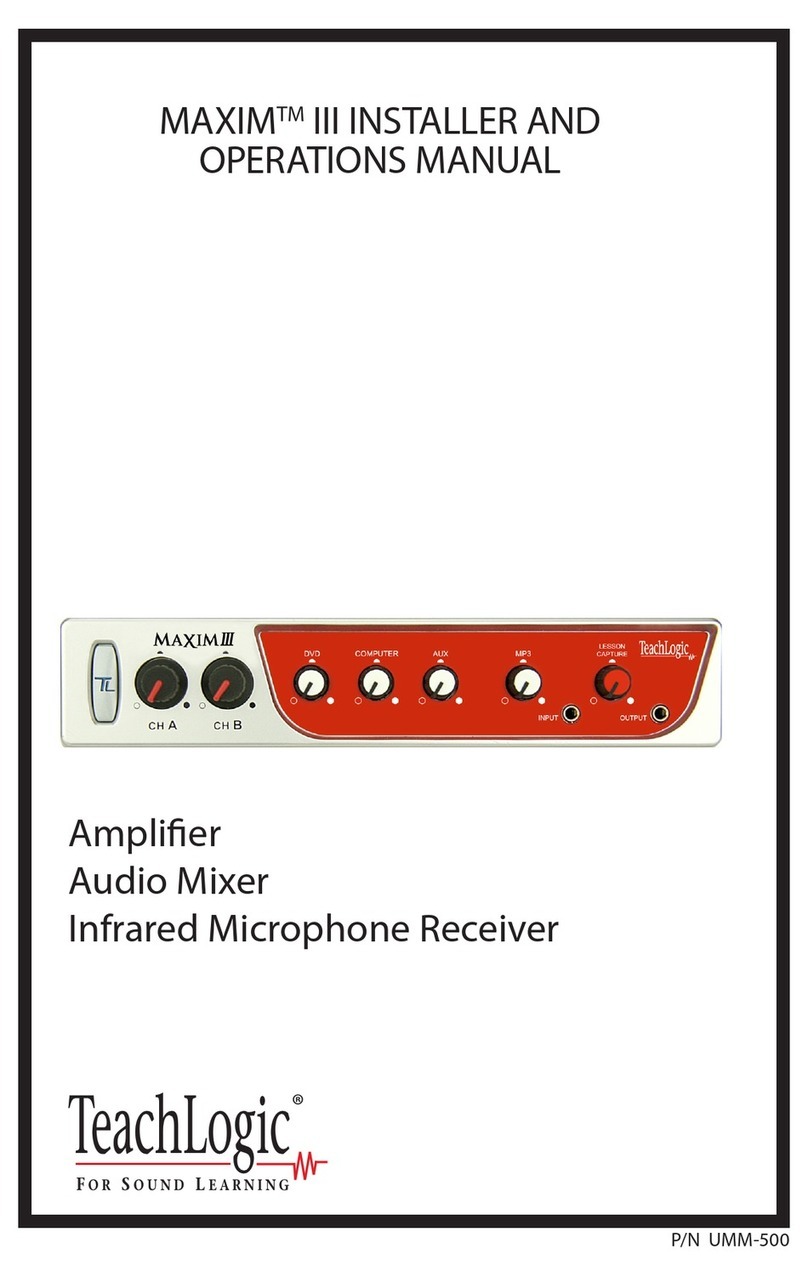
TeachLogic
TeachLogic Maxim III User manual
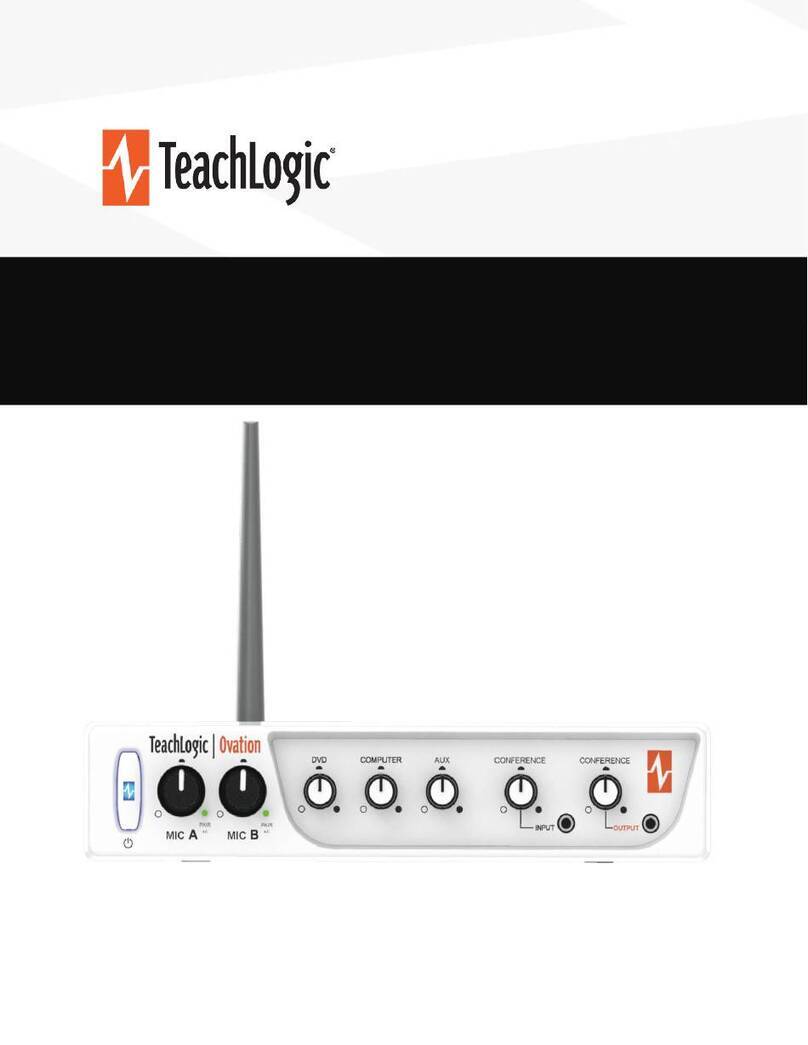
TeachLogic
TeachLogic Ovation OA-50 User manual
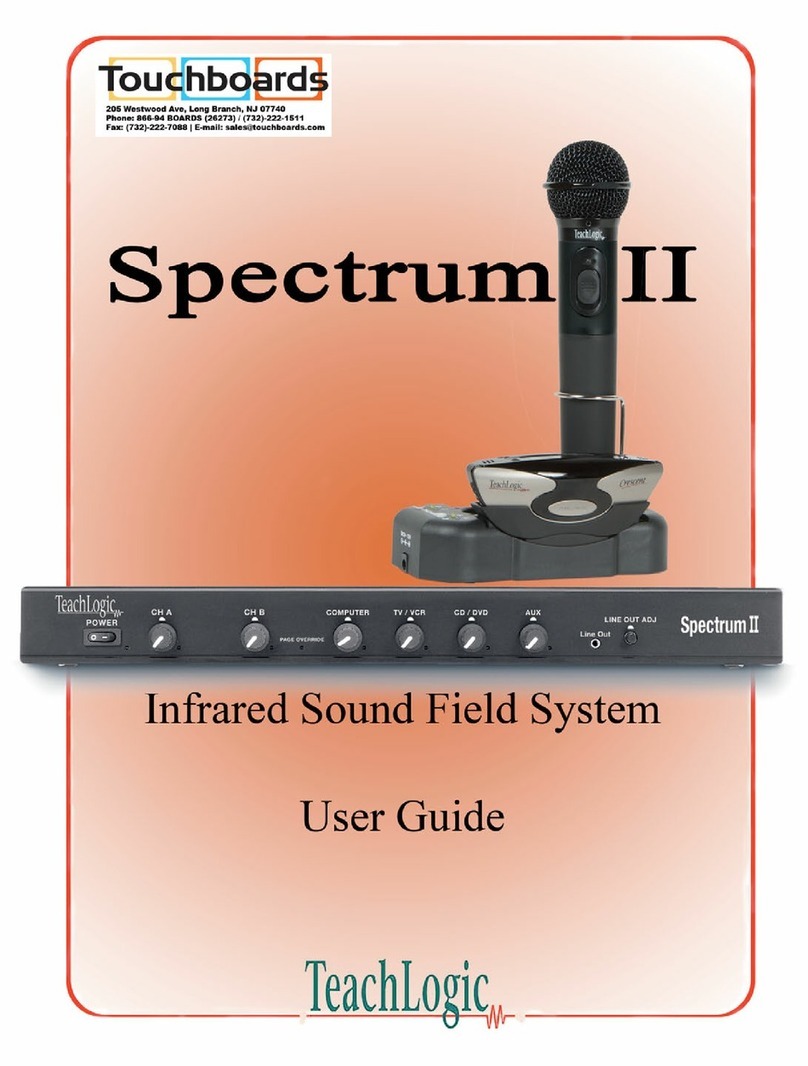
TeachLogic
TeachLogic Spectrum II User manual
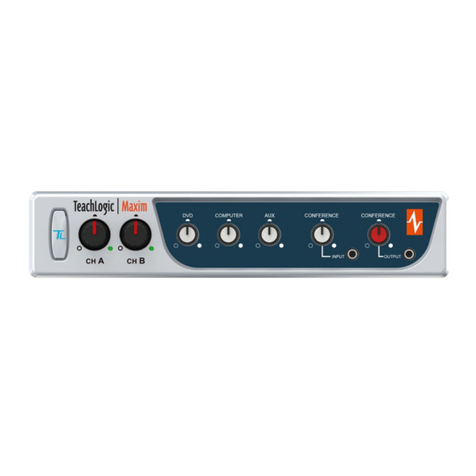
TeachLogic
TeachLogic Maxim IMA-540 User manual
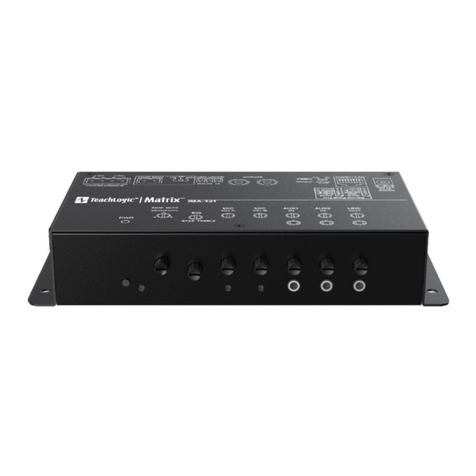
TeachLogic
TeachLogic Matrix IMA-121 User manual
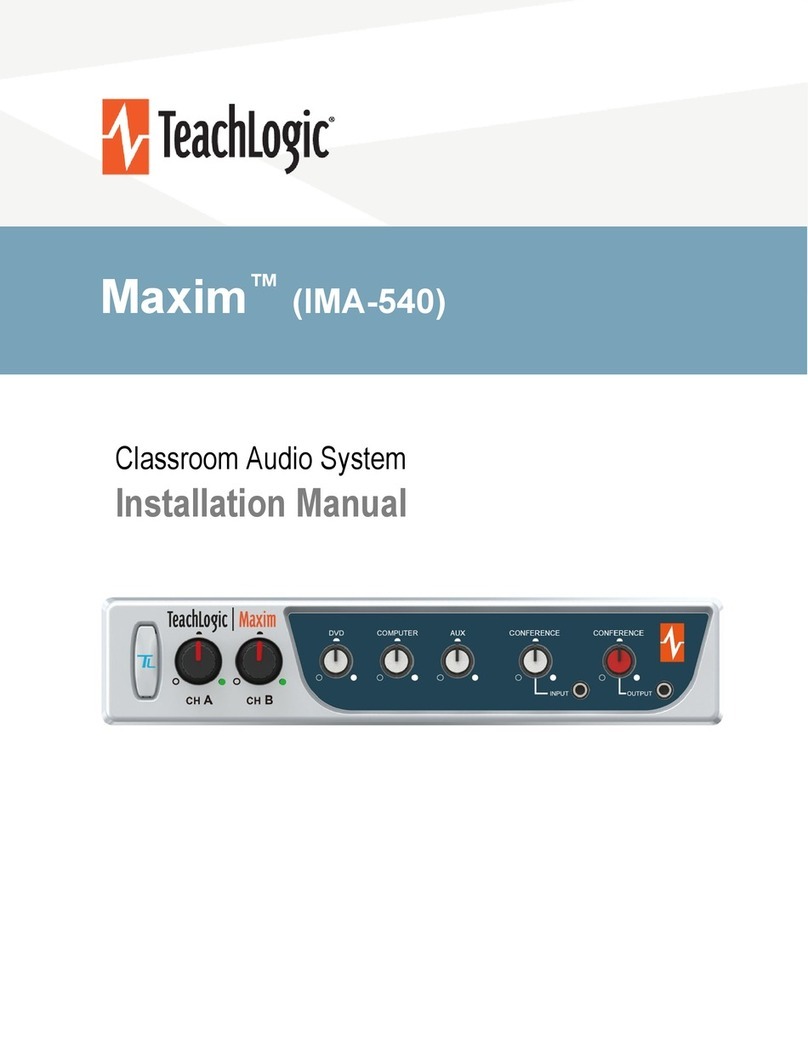
TeachLogic
TeachLogic Maxim IRM-6650 User manual
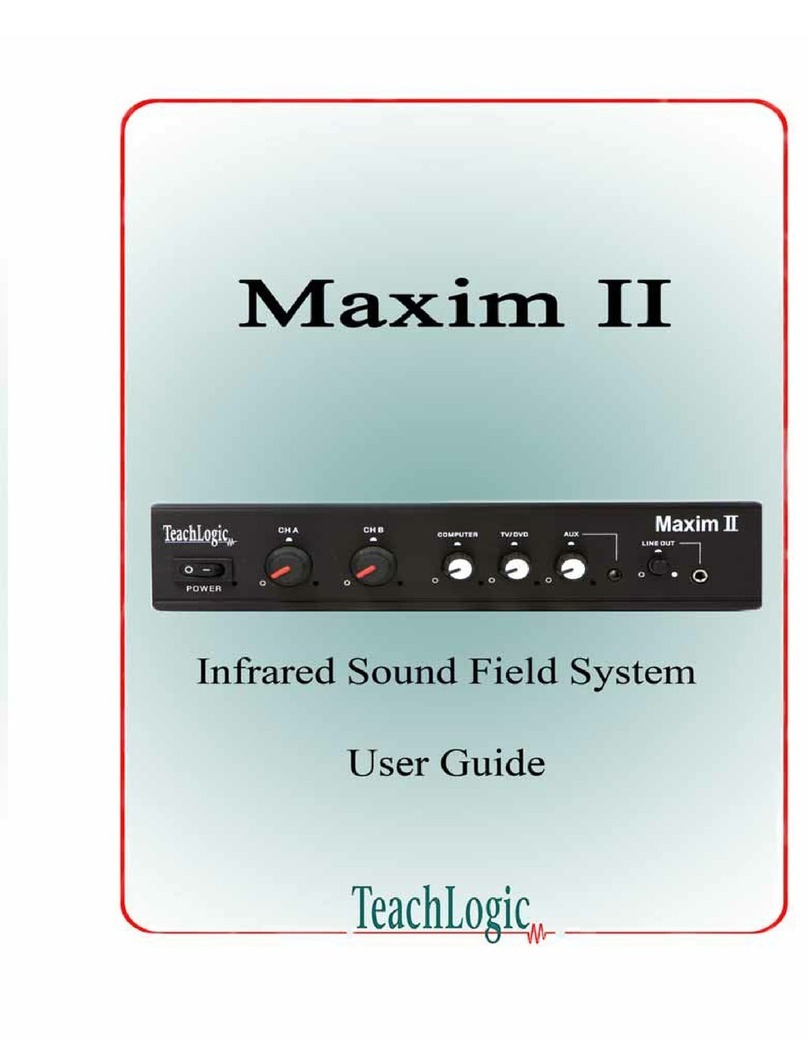
TeachLogic
TeachLogic Maxim II User manual
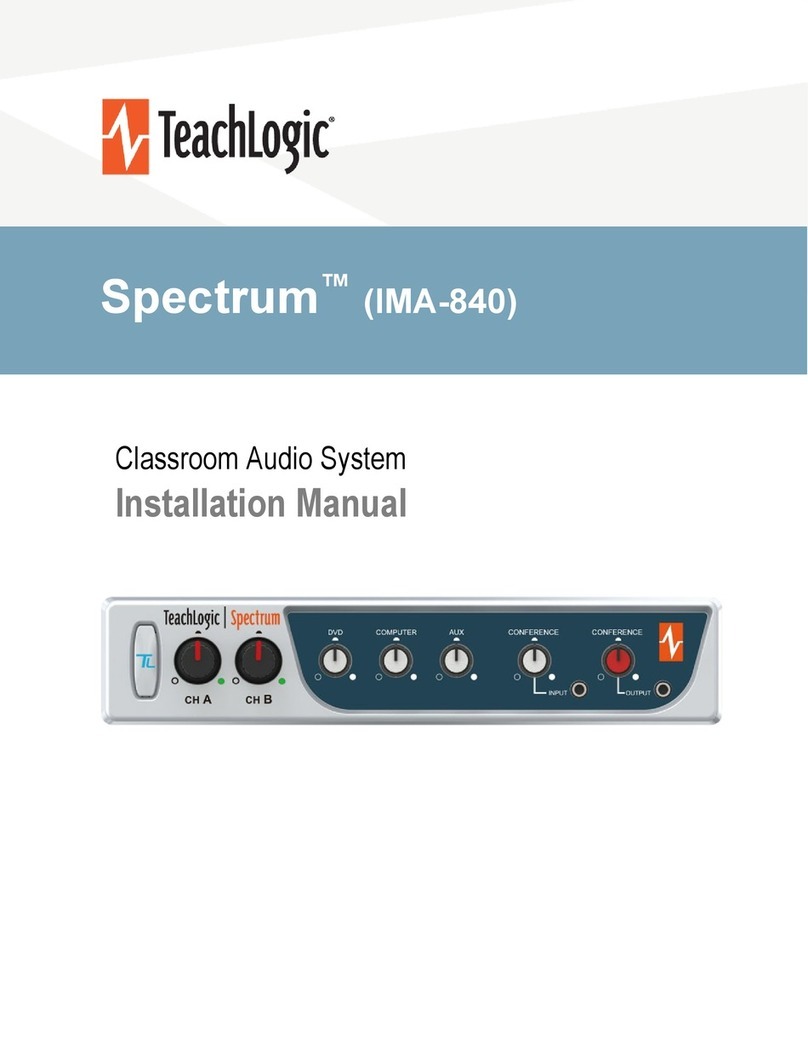
TeachLogic
TeachLogic Spectrum IRS-9650 User manual
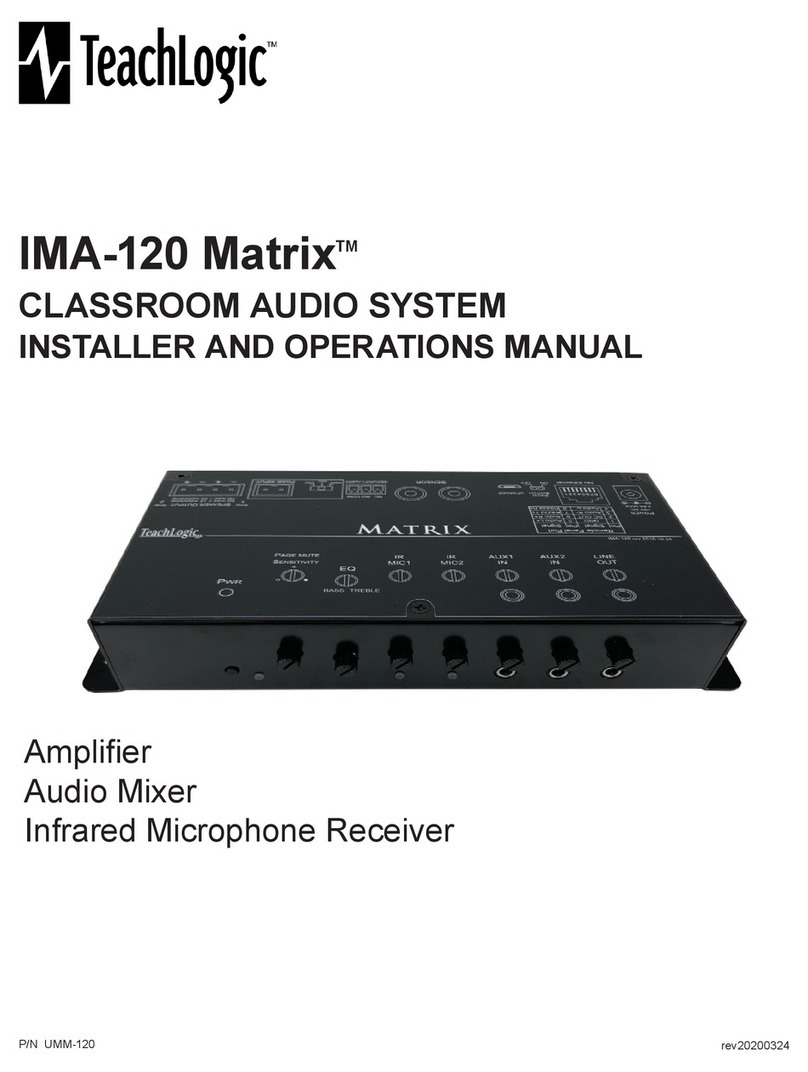
TeachLogic
TeachLogic Matrix User manual
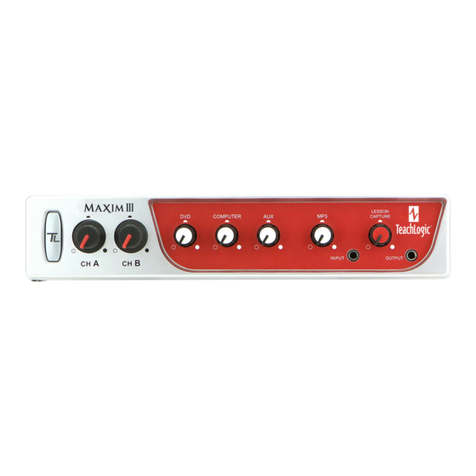
TeachLogic
TeachLogic Maxim III User manual
